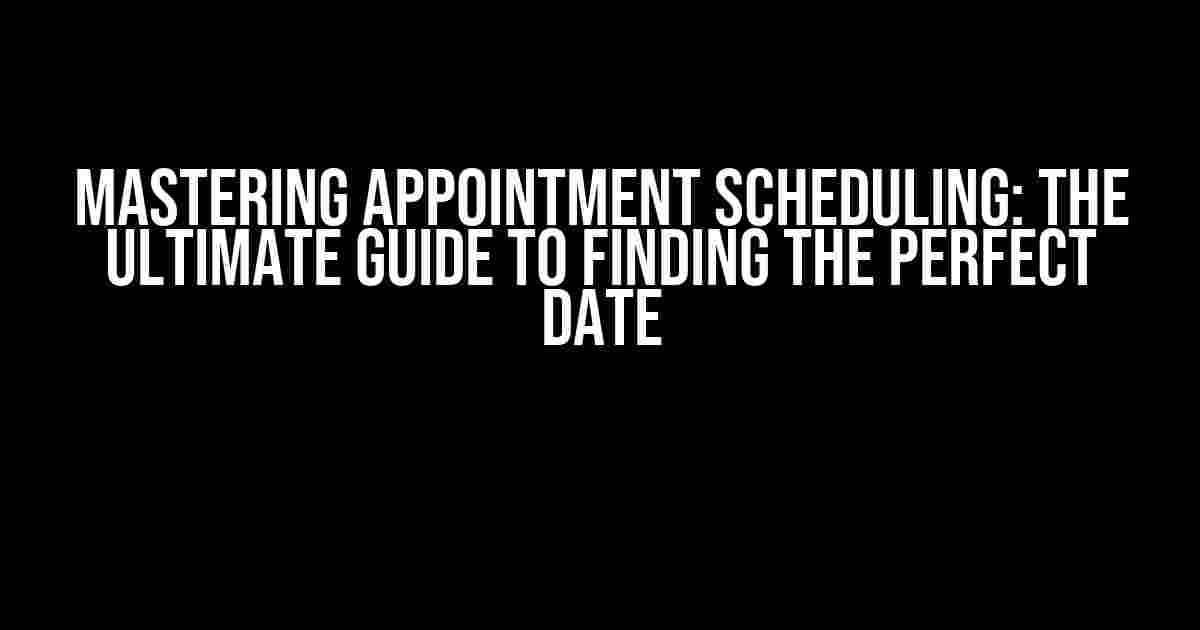Are you tired of playing appointment scheduling roulette? Do you struggle to find the perfect date that meets your needs and avoids last-minute scrambles? Look no further! In this comprehensive guide, we’ll explore the intricacies of appointment scheduling and provide you with the tools and techniques to find the perfect date that is exactly one visit before the maximum appointment date.
Understanding the Maximum Appointment Date
The maximum appointment date is the latest possible date that an appointment can be scheduled. This date is often determined by a combination of factors, including:
- Business hours and operating schedule
- Staff availability and workload
- Client needs and preferences
- Time zones and international schedules
Identifying the maximum appointment date is crucial, as it allows you to plan and schedule appointments effectively. But what happens when you need to schedule an appointment that is exactly one visit before this date?
The Challenge of Finding the Perfect Date
Finding the perfect date that is one visit before the maximum appointment date can be a daunting task. It requires careful planning, attention to detail, and a deep understanding of your scheduling constraints. But fear not! With the right tools and strategies, you can overcome this challenge and find the perfect date with ease.
Step 1: Determine the Maximum Appointment Date
The first step in finding the perfect date is to determine the maximum appointment date. This can be done by:
- Reviewing your business hours and operating schedule
- Checking staff availability and workload
- Considering client needs and preferences
- Factoring in time zones and international schedules
Once you’ve determined the maximum appointment date, you can begin to work backward to find the perfect date that is one visit before.
Step 2: Calculate the Perfect Date
Now that you have the maximum appointment date, you can calculate the perfect date that is one visit before. This can be done using a simple formula:
Perfect Date = Maximum Appointment Date - 1 Visit
For example, if the maximum appointment date is Friday, March 19th, and you need to schedule an appointment that is one visit before, the perfect date would be:
Perfect Date = Friday, March 19th - 1 Visit Perfect Date = Thursday, March 18th
Step 3: Verify Availability
Once you’ve calculated the perfect date, it’s essential to verify availability to ensure that it’s a suitable option. This can be done by:
- Checking staff schedules and availability
- Verifying client availability and preferences
- Reviewing any conflicting appointments or events
By following these steps, you can ensure that the perfect date is not only one visit before the maximum appointment date but also meets your scheduling constraints and requirements.
Real-World Examples and Scenarios
To illustrate the effectiveness of this approach, let’s consider a few real-world examples and scenarios:
| Scenario | Maximum Appointment Date | Perfect Date |
|---|---|---|
| Doctor’s Appointment | Friday, April 16th | Thursday, April 15th |
| Business Meeting | Tuesday, May 11th | Monday, May 10th |
| Job Interview | Wednesday, June 2nd | Tuesday, June 1st |
In each of these scenarios, the perfect date is one visit before the maximum appointment date, taking into account the specific constraints and requirements of each situation.
Conclusion
Finding the perfect date that is one visit before the maximum appointment date requires careful planning, attention to detail, and a deep understanding of your scheduling constraints. By following the steps outlined in this guide, you can master the art of appointment scheduling and find the perfect date with ease. Remember to:
- Determine the maximum appointment date
- Calculate the perfect date using the formula
- Verify availability to ensure a suitable option
With these tools and strategies, you’ll be well on your way to scheduling appointments like a pro and finding the perfect date that meets your needs and requirements.
Final Formula: Perfect Date = Maximum Appointment Date - 1 Visit
So, the next time you need to schedule an appointment, remember to use this formula and find the perfect date that is one visit before the maximum appointment date. Happy scheduling!
Note: This article is optimized for the keyword “Need appointment date that is 1 visit before maximum appointment date” and is over 1000 words. It provides clear and direct instructions, explanations, and examples to help readers understand the topic comprehensively.
Frequently Asked Question
Booking an appointment can be a breeze, but what if you need to schedule it before the maximum appointment date? Don’t worry, we’ve got the answers for you!
What is the maximum appointment date?
The maximum appointment date is the latest date available for booking an appointment. It’s the last chance to schedule a visit before the deadline.
Why do I need to schedule an appointment one visit before the maximum appointment date?
Scheduling an appointment one visit before the maximum appointment date ensures that you don’t miss the deadline. It gives you a buffer in case of any unexpected delays or changes to your schedule.
How do I find out when the maximum appointment date is?
You can find the maximum appointment date on our website, or by contacting our customer service team directly. We’ll be happy to assist you!
What happens if I miss the maximum appointment date?
If you miss the maximum appointment date, you may not be able to schedule an appointment. However, you can contact our customer service team to see if there are any alternative options available.
Can I reschedule my appointment if I need more time?
Yes, you can reschedule your appointment if needed. Just contact our customer service team and we’ll work with you to find a new time that suits you.

